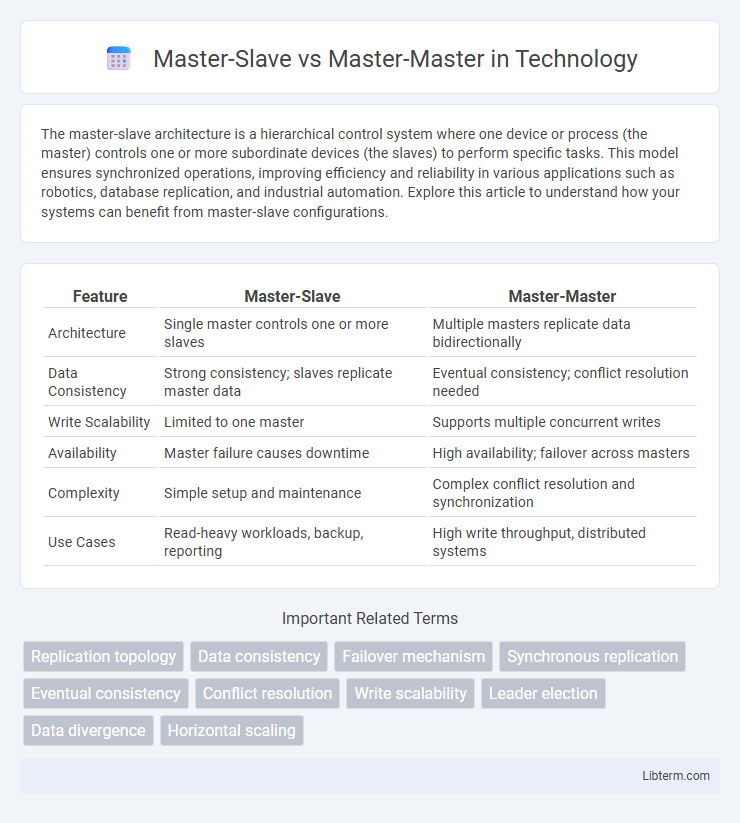The master-slave architecture is a hierarchical control system where one device or process (the master) controls one or more subordinate devices (the slaves) to perform specific tasks. This model ensures synchronized operations, improving efficiency and reliability in various applications such as robotics, database replication, and industrial automation. Explore this article to understand how your systems can benefit from master-slave configurations.
Table of Comparison
| Feature | Master-Slave | Master-Master |
|---|---|---|
| Architecture | Single master controls one or more slaves | Multiple masters replicate data bidirectionally |
| Data Consistency | Strong consistency; slaves replicate master data | Eventual consistency; conflict resolution needed |
| Write Scalability | Limited to one master | Supports multiple concurrent writes |
| Availability | Master failure causes downtime | High availability; failover across masters |
| Complexity | Simple setup and maintenance | Complex conflict resolution and synchronization |
| Use Cases | Read-heavy workloads, backup, reporting | High write throughput, distributed systems |
Introduction to Database Replication Models
Master-Slave replication involves one primary database (master) handling all write operations while one or more secondary databases (slaves) replicate data for read operations, ensuring data consistency and fault tolerance. Master-Master replication enables multiple masters to handle write operations simultaneously, providing high availability and load balancing but requiring conflict resolution mechanisms. Both models enhance database performance and scalability by distributing workloads, with Master-Slave favoring read scalability and Master-Master supporting multi-primary write environments.
Understanding Master-Slave Architecture
Master-Slave architecture features one primary database server (the master) handling all write operations while multiple secondary servers (slaves) replicate data and manage read queries, optimizing read scalability and data redundancy. This model ensures data consistency by directing all updates through the master, preventing conflicts that can arise with concurrent writes in distributed systems. Commonly used in relational databases like MySQL, Master-Slave replication simplifies backup processes and failover strategies but may introduce latency between master and slave synchronization.
Understanding Master-Master Architecture
Master-Master architecture enables simultaneous read and write operations across multiple database nodes, improving availability and fault tolerance compared to Master-Slave setups where only the master handles writes. Data synchronization in Master-Master systems relies on conflict resolution mechanisms like timestamps or version vectors to maintain consistency across nodes. This distributed approach supports load balancing and high scalability, making it ideal for applications requiring continuous uptime and multi-region data replication.
Data Consistency and Conflict Resolution
Master-Slave replication ensures strong data consistency by design, as all write operations occur on the master node, reducing the risk of conflicts but introducing potential latency in slave synchronization. Master-Master replication enables high availability and write scalability by allowing updates on multiple nodes, but it requires sophisticated conflict resolution strategies such as vector clocks or last-write-wins to handle concurrent data changes. Data consistency in Master-Master setups can vary between eventual and strong consistency models, depending on the conflict resolution algorithm and network conditions.
Performance and Scalability Comparison
Master-Slave replication offers high read performance by distributing read requests across multiple slaves, but write operations are limited to a single master, which can become a bottleneck affecting scalability. Master-Master replication enables concurrent writes on multiple nodes, enhancing write availability and horizontal scalability, though it introduces complexity in conflict resolution and synchronization overhead that can impact overall performance. The choice depends on workload patterns: Master-Slave is ideal for read-heavy applications requiring simple scaling, while Master-Master suits environments demanding high write throughput and fault tolerance.
Failover and High Availability
Master-Slave replication architecture involves one primary node handling write operations with one or more secondary nodes replicating data for read operations, ensuring failover by promoting a slave to master if the primary fails, though failover time depends on detection and promotion mechanisms. Master-Master replication supports multiple nodes simultaneously accepting writes, providing higher availability by eliminating single points of failure and enabling faster failover since nodes can seamlessly take over each other's workloads. However, Master-Master requires conflict resolution mechanisms due to concurrent writes, while Master-Slave simplifies consistency at the cost of potential failover delays and limited write scalability.
Use Cases and Best Scenarios
Master-Slave replication excels in read-heavy environments with a single source of truth, making it ideal for scenarios like reporting databases or backup systems where data consistency and failover recovery are critical. Master-Master replication suits high-availability applications requiring write scalability and multi-region deployments, such as distributed transaction systems and collaborative platforms where concurrent updates must be synchronized. Choosing between them depends on workload patterns: Master-Slave optimizes read performance and simplicity, while Master-Master enables fault tolerance and write redundancy across multiple nodes.
Potential Challenges and Limitations
Master-slave replication can face challenges such as single point of failure, read scalability limitations, and replication lag impacting data consistency. Master-master setups often encounter conflict resolution complexities, increased operational overhead, and potential data inconsistency due to simultaneous writes. Both architectures require careful design to address latency, failover, and synchronization issues in distributed systems.
Security Considerations in Replication
Master-Slave replication offers a clearer security boundary by isolating write operations to the master node, reducing attack surface and simplifying access control policies. Master-Master replication requires robust conflict resolution and secure authentication mechanisms on all nodes to prevent unauthorized data modification and replication conflicts. Encryption of data in transit and strict role-based access controls are essential in both architectures to safeguard replication channels and ensure data integrity.
Choosing the Right Model for Your Needs
Master-Slave replication offers simplicity and is ideal for read-heavy workloads with predictable write patterns, ensuring data redundancy and easier conflict resolution. Master-Master replication supports high availability and write scalability by allowing simultaneous writes on multiple nodes, but requires conflict resolution mechanisms and more complex synchronization. Selecting the appropriate model depends on factors like application consistency requirements, write-read balance, and system complexity tolerance.
Master-Slave Infographic

 libterm.com
libterm.com